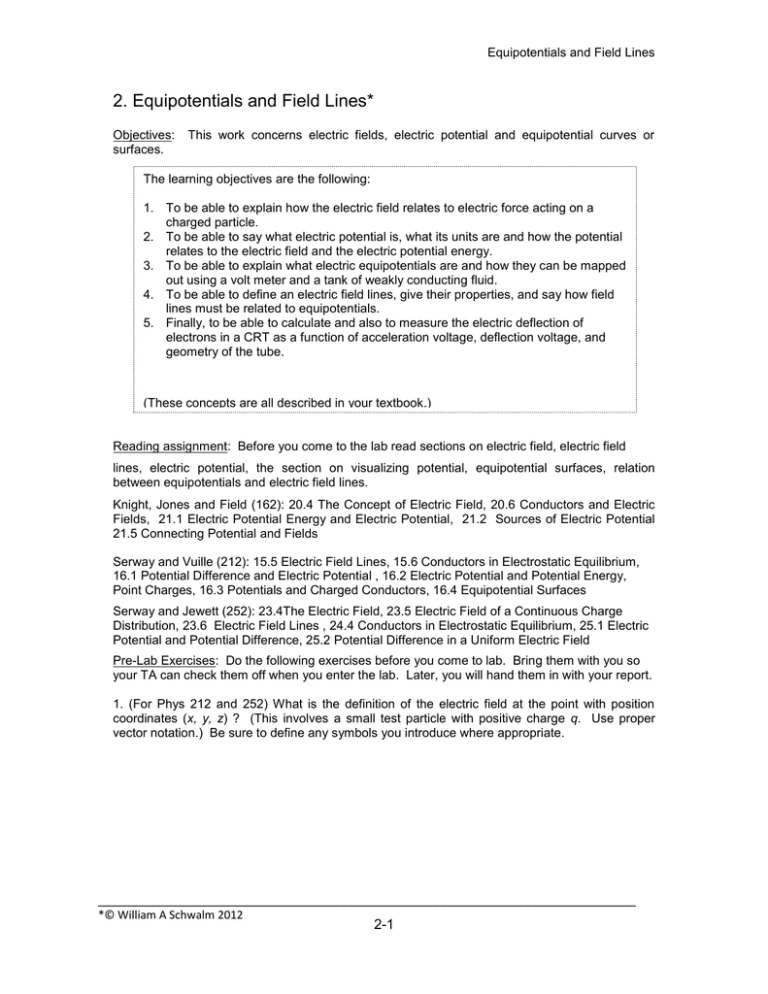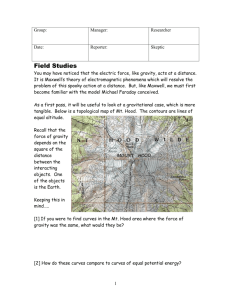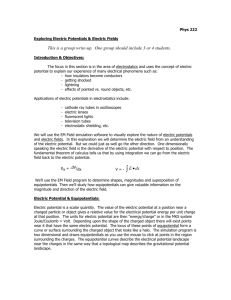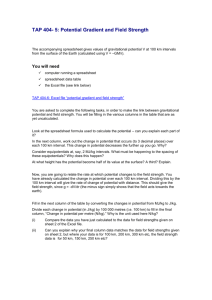2. Equipotentials and Field Lines*
advertisement

Equipotentials and Field Lines 2. Equipotentials and Field Lines* Objectives: surfaces. This work concerns electric fields, electric potential and equipotential curves or The learning objectives are the following: 1. To be able to explain how the electric field relates to electric force acting on a charged particle. 2. To be able to say what electric potential is, what its units are and how the potential relates to the electric field and the electric potential energy. 3. To be able to explain what electric equipotentials are and how they can be mapped out using a volt meter and a tank of weakly conducting fluid. 4. To be able to define an electric field lines, give their properties, and say how field lines must be related to equipotentials. 5. Finally, to be able to calculate and also to measure the electric deflection of electrons in a CRT as a function of acceleration voltage, deflection voltage, and geometry of the tube. (These concepts are all described in your textbook.) Reading assignment: Before you come to the lab read sections on electric field, electric field lines, electric potential, the section on visualizing potential, equipotential surfaces, relation between equipotentials and electric field lines. Knight, Jones and Field (162): 20.4 The Concept of Electric Field, 20.6 Conductors and Electric Fields, 21.1 Electric Potential Energy and Electric Potential, 21.2 Sources of Electric Potential 21.5 Connecting Potential and Fields Serway and Vuille (212): 15.5 Electric Field Lines, 15.6 Conductors in Electrostatic Equilibrium, 16.1 Potential Difference and Electric Potential , 16.2 Electric Potential and Potential Energy, Point Charges, 16.3 Potentials and Charged Conductors, 16.4 Equipotential Surfaces Serway and Jewett (252): 23.4The Electric Field, 23.5 Electric Field of a Continuous Charge Distribution, 23.6 Electric Field Lines , 24.4 Conductors in Electrostatic Equilibrium, 25.1 Electric Potential and Potential Difference, 25.2 Potential Difference in a Uniform Electric Field Pre-Lab Exercises: Do the following exercises before you come to lab. Bring them with you so your TA can check them off when you enter the lab. Later, you will hand them in with your report. 1. (For Phys 212 and 252) What is the definition of the electric field at the point with position coordinates (x, y, z) ? (This involves a small test particle with positive charge q. Use proper vector notation.) Be sure to define any symbols you introduce where appropriate. ______________________________________________________________________ *© William A Schwalm 2012 2-1 Equipotentials and Field Lines -4 2. If a small particle with electric charge q = - 3.5 x 10 Coulombs is placed at the point with coordinates (-4.0m, 2.1m, 2.2m) where the x, y and z components of the electric field vector are Ex = -10.5 Newtons/Coulomb, Ey = 10.5 Newtons/Coulomb, Ez = - 8.0 Newtons/Coulomb, what is the force acting on the particle? 3. How is the electric potential energy of a charged particle with charge q at a given point related to the electric potential, or the voltage, at that point? Give a formula. 4. Equipotential surfaces are imaginary surfaces over which the electric potential in a given problem is constant. Electric field lines are directed curves such that at each point in space the curve is directed along the electric field. Explain how (geometrically) the electric field lines are related to the equipotential surfaces. 5. The figure at the right shows a cross-sectional view of a conducting metal fin (above) at 10,000 Volts and a flat metal ground plane at 0 Volts. Sketch in your best estimate of how the field lines and the equipotentials would look. Represent field lines as lines with arrow heads on them to indicate direction, and the equipotentials as dashed curves. Draw at least five field lines and three equipotentials. Scenario: Your group is assigned to a project at Nanosystems Inc. This corporation makes electron microscopes and other surface probes involving electron optics, in which electrons rather than light are used to form images. The general shape of a cylendrical electrostatic lens is as shown at the right in a cur-away view. This is a prototype for the objective lens for a new instrument in early stages of development. Cut-away view The design team needs to know as much as possible about the electric potential inside the lens. They have computed an electric field map, but to be sure of the calculation, it was decided that your team would do water-tank measurements on a scale model of a portion of the lens, and actually draw some of the equipotentials by experimental measurement. 2-2 Equipotentials and Field Lines The water-tank model will look like half of a cross section of the lens. (Be prepared to explain this.) Therefore, what needs to be done is to make careful measurements of equipotentials around the segment of the lens as represented by this model. The water tank method makes use of the fact that, when a weak electric current flows through the water, the voltage (which is the same as the potential) at a given point can be measured using a high-impedence volt meter. In-class questions for group response: 1. Inside a good conductor in equilibrium, such as aluminum with only small current flowing, there is almost no electric field. This is because the electrons move around and cancel out the field. What does this tell you about the electric potential inside or on the surface of a conductor? (You may consider the following picture of a path between points on the surface of a conductor. How much work is done against the electric force on a charge as you move it along this path? What does it tell you?) b a 2. On your white board, draw a prediction for several of the equipotentials for a parallel plate capacitor formed by two parallel conductors as shown. There are three equipotentials that you can draw exactly. Suppose for instance that the right-hand bar is at +3 Volts and the other one is at 0 Volts (grounded). Then which three equipotentials do you know right away? Draw them in your picture and also include your estimates for at least two other equipotentials. 3. On the white board, make a sketch of the mock-up right-hand lens segment as shown above. On the sketch, show your prediction for several of the equipotentials. (In the water tank, everything is two dimensional, so the equipotentials are curves rather than surfaces.) 2-3 Equipotentials and Field Lines Exploring the Apparatus: The experimental setup consists of the following items, as shown in the photo: 913 inch Pyrex baking pan, digital multimeter, connecting wires, two alligator clips, one long probing wire (banana-probe, aluminum electrodes (two ½ inch diameter cylindrical and two ¾ x 6 x1/4 inch bar shape) clear plastic sheet (not shown, 1 8 1824 inch), Two sheets of graph paper and one piece of graph paper to place under the pan. Below the tank of water you can place a coordinate grid to use for making position measurements. If you attach the common lead of the voltmeter to one of the conducting objects, you can call that zero potential. Other potentials would be measured relative to this reference point. Set up a simple configuration of conductors, such as the one shown, and practice mapping out an equipotential curve until you get some idea of how things work. Develop a method involving teamwork. For instance one person could use the probe and locate points of the chosen potential and then report the coordinates. Another could record them. It is best to record them directly as points on a piece of graph paper, which should be provided. Team members should take turns each of doing these tasks. Work Assignment: The team must produce a report describing the equipotential surfaces and electric field lines inside the electrostatic lens. For a check, you should first prepare a similar study of the field lines and equipotentials inside a parallel plate capacitor, making note of the socalled “fringe field.” In each case you should collect sufficient data and draw at least three equipotentials (in addition to the conductor surfaces) and use those to draw at least four field lines (in addition to the center line). Measurement Plan: Based on the exploration, your team should decide on a plan for mapping out the equipotentials of any given set-up. This should include a description of what each team member is going to do during the measurement, what data will be recorded and then how the data will be used. Be specific. Outline your plan on the white board and be prepared to report it to the class. Make a copy of your plan here. 2-4 Equipotentials and Field Lines (Plan continued) Implementation: Put your measurement plan into action. Take the necessary data for the parallel plate capacitor, and then also for the lens segment mock-up. Record the data and relevant observations here. Your team will produce graphical representations of equipotential curves and field lines. These should be photocopied and shared among group members. Attach them also to your final report. Recap: Before you leave the laboratory, take time to review with your team members the learning objectives in the box above. Be ready to comment on how the lab activities have related to each of these objectives. 2-5 Equipotentials and Field Lines 2-6








